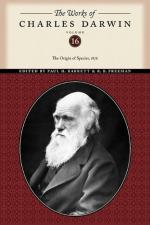Thus, as it seems to me, the leading facts in embryology, which are second in importance to none in natural history, are explained on the principle of slight modifications not appearing, in the many descendants from some one ancient progenitor, at a very early period in the life of each, though perhaps caused at the earliest, and being inherited at a corresponding not early period. Embryology rises greatly in interest, when we thus look at the embryo as a picture, more or less obscured, of the common parent-form of each great class of animals.
Rudimentary, atrophied, or aborted organs.
Organs or parts in this strange condition, bearing the stamp of inutility, are extremely common throughout nature. For instance, rudimentary mammae are very general in the males of mammals: I presume that the “bastard-wing” in birds may be safely considered as a digit in a rudimentary state: in very many snakes one lobe of the lungs is rudimentary; in other snakes there are rudiments of the pelvis and hind limbs. Some of the cases of rudimentary organs are extremely curious; for instance, the presence of teeth in foetal whales, which when grown up have not a tooth in their heads; and the presence of teeth, which never cut through the gums, in the upper jaws of our unborn calves. It has even been stated on good authority that rudiments of teeth can be detected in the beaks of certain embryonic birds. Nothing can be plainer than that wings are formed for flight, yet in how many insects do we see wings so reduced in size as to be utterly incapable of flight, and not rarely lying under wing-cases, firmly soldered together!




